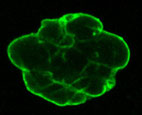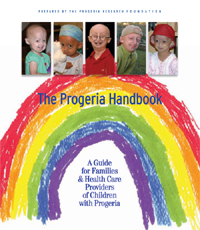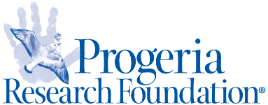Progeria 101/FAQ
What is Progeria?
Hutchinson-Gilford Progeria Syndrome “Progeria” or “HGPS” is a rare, fatal genetic condition characterized by an appearance of accelerated aging in children*. Its name is derived from Greek and means “prematurely old.” While there are different forms of Progeria*, the classic type is Hutchinson-Gilford Progeria Syndrome, which was named after the doctors who first described it in England: in 1886 by Dr. Jonathan Hutchinson, and in 1897 by Dr. Hastings Gilford.
Did you know?
Progeria is caused by a tiny point mutation in a child’s DNA, a one-letter typo in the billions of letters that make up the chromosomal book.
* Other Progeroid syndromes include Werner syndrome, also known as “adult progeria” which does not have an onset until the late teen years, with a lifespan into the 40’s and 50’s. Click here for information on Werner Syndrome
How common is Progeria?
Progeria affects approximately 1 in 20 million people. There are an estimated 350-400 children living with Progeria worldwide at any one time. It affects both sexes equally and all races. Since The Progeria Research Foundation was created in 1999, we have discovered children with Progeria living in 52 countries and speaking 32 languages.
For a map of where living children reside, please go to our Meet the Kids page.
What are the features of Progeria?
Although they are usually born looking healthy, most children with Progeria begin to display many characteristics of Progeria within the first 2 years of life. Progeria signs include growth failure, loss of body fat and hair, aged-looking skin and stiffness of joints. As children get older, they suffer from osteoporosis, generalized atherosclerosis, cardiovascular (heart) disease and stroke. The children have a remarkably similar appearance despite differing ethnic backgrounds. Children with Progeria die of atherosclerosis (heart attacks or strokes) at an average age of fourteen years.
What is the cause of Progeria?
HGPS is caused by a mutation in the gene called LMNA (pronounced “lamin-a”). The LMNA gene produces the lamin A protein which is the structural scaffolding that holds the nucleus of a cell together. The abnormal lamin A protein that causes Progeria is called progerin. Progerin makes the nucleus unstable. That cellular instability leads to the process of premature aging and disease in Progeria.
 Progeria Cell Nucleus Progeria Cell Nucleus |
PRF was the driving force behind finding the gene responsible for Progeria. A group of leading scientists from PRF’s Genetics Consortium was able to isolate the Progeria gene, and in April 2003, PRF led the announcement reported in the top scientific journal Naturev.
“Isolating the Progeria gene is a major achievement for the medical research community,” said Dr. Francis Collins, Director of the National Institutes of Health and senior discoverer of the Progeria gene, “The discovery not only gives hope to children and families affected by
Progeria, but also may shed light on the phenomenon of aging and cardiovascular disease.”
v “Recurrent de novo point mutations in lamin A cause Hutchinson-Gilford Progeria Syndrome”, Nature, Vol. 423, May 15, 2003.
What does Progeria have to do with aging?
We now know that there is a biological overlap between children with Progeria and the general aging population. We all make a little bit of progerin, the disease-causing protein in Progeria. We make much less progerin than children with Progeria, but the progerin builds up over a lifetime and may be partly responsible for aspects of aging such as atherosclerosis. Progerin is also linked to telomere dysfunction. Telomeres are proteins that play a major role in cellular aging.
Children with Progeria are genetically predisposed to premature, progressive heart disease. Death occurs almost exclusively due to widespread heart disease, the leading cause of death worldwide.+ Thus, there is clearly a tremendous need for research in Progeria. Finding a cure for Progeria will not only help these children, but may provide keys for treating millions of adults with heart disease and stroke associated with the natural aging process.
+ 2016 American Heart Association Heart Disease and Stroke Statistics
Is Progeria passed down from parent to child?
HGPS is not usually passed down in families. The gene change is almost always a chance occurrence that is extremely rare. Children with other types of “progeroid” syndromes which are not HGPS may have diseases that are passed down in families. However, HGPS is a “sporadic autosomal dominant” mutation – sporadic because it is a new change in that family, and dominant because only one copy of the gene needs to be changed in order to have the syndrome. For parents who have never had a child with Progeria, the chances of having a child with Progeria are 1 in 20 million. But for parents who have already had a child with Progeria, the chances of it happening again to those parents is much higher – about 2-3%. Why the increase? This is due to a condition called “mosaicism”, where a parent has the genetic mutation for Progeria in a small proportion of their cells, but does not have Progeria. Prenatal testing is available to look for the LMNA genetic change that causes HGPS.
How is Progeria diagnosed?
Now that the gene mutation has been identified, The Progeria Research Foundation has a Diagnostic Testing Program. We can now look at the specific genetic change, or mutation, in the Progeria gene that leads to HGPS. After an initial clinical evaluation (looking at the child’s appearance and medical records), a sample of the child’s blood will be tested for Progeria. PRF provides a definitive, scientific way to diagnose the children. This leads to more accurate and earlier diagnoses so the children can receive proper care.
What is PRF doing to help children with Progeria?
 |
The Progeria Research Foundation funds medical research aimed at developing treatments and a cure for Progeria. PRF also has its own Cell & Tissue Bank that provides the biological materials researchers need to conduct their experiments. Additionally, PRF has established a Medical & Research Database to supply physicians and families with medical recommendations for cardiac care, nutrition and other medical issues to help children and adults with Progeria have a better quality of life. We continue to analyze medical records of children and adults with Progeria so that we can provide information on how best to medically help those with Progeria, and provide clues towards potential new treatments. In April 2010, PRF published The Progeria Handbook for families and doctors. From basic health facts to daily care recommendations to extensive treatment guidelines, the handbook helps answer many questions for people suffering from Progeria throughout the world. The Handbook is available in English, Spanish and Portuguese.
PRF is also driving Progeria clinical drug trials testing potential treatments. To date, PRF has funded and co-coordinated three clinical trials. Please refer to our clinical drug trials section for more details. History was made in September 2012 with the discovery that the drug involved in the first clinical trial, a farnesyltransferase inhibitor or FTI , is the first-ever treatment for Progeria ♦. PRF continues to explore other promising drugs that will bring us to a cure for Progeria.
♦ Proc Natl Acad Sci U S A. 2012 Sep 24. [Epub ahead of print]
What can you do to help children with Progeria?
- Make a financial contribution. Donations are needed to continue the vital work of PRF. No donation is too little or too big – every dollar counts in our quest for a cure! Online donations are accepted on our Ways to Donate page.
- Donate your time. Volunteers are also important to PRF’s success. Hold a special event like a bake sale or letter writing campaign; translate documents for the families; help with a mailing – we’ll find something for you to do that fits your schedule, location and talents! Visit our Get Involved page to see all the ways you can help.
- Donate in-kind services or items. Do you own a printing or office supply business? Are you a computer whiz that can help with our Twitter, Facebook, web site and/or other on-line presence? Do you have a business background in non-profit development? These are just some of the many types of talents and connections PRF needs. The more tasks we can get accomplished on a pro bono basis, the more money we can devote to research!
- Spread the word and tap into your connections. Do you know anyone who can help? Tell your friends, family and colleagues about PRF and the amazing work we’re doing! Many times, people are more likely to donate to an organization if they’ve gotten a recommendation from someone they know. So put in a good word for us and tell everyone to visit our web site at www.progeriaresearch.org , follow us on Twitter, “like” us on Facebook, and contact us at info@progeriaresearch.org
TOGETHER WE WILL FIND THE CURE!
